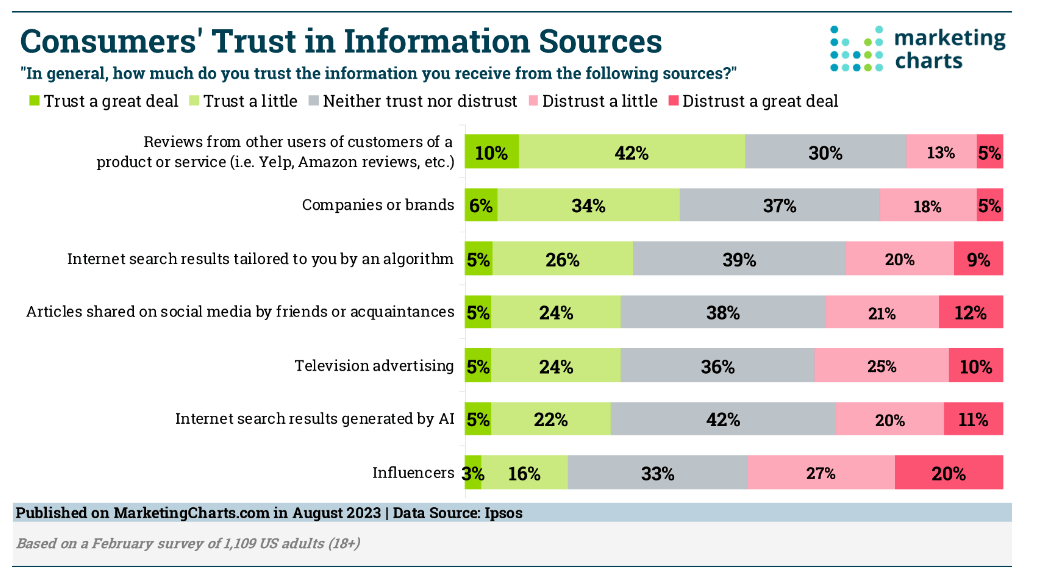How often have you seen people embrace a new trend simply because everyone else is doing it or buy a product based on someone else's positive experience? Many times, surely.
Social proof can have a contagious effect, as it bulletproofs products and services with credibility and trustworthiness. Seeing other people’s endorsements also reduces perceived risk. Everyone is more likely to try, buy, or use something if the likelihood of a satisfactory experience is high.
Similar psychological factors come into play when a user visits a website for the first time. Potential customers may be thrilled with what they see, but that’s not enough to grab their wallets. Instead, they’ll want to hear from other consumers whether what your business offers is worth a purchase.
Customer testimonials will be among their first stops on your site. Other people’s reviews help users learn about your company’s practices and product quality.
However, these reviews must appear authentic and genuine to be persuasive. This article will dive into everything you should know about customer testimonials, from how to request them to how to frame them.
What are Customer Testimonials?
Customer testimonials are firsthand accounts of happy customers sharing their positive experiences with your product or service. These testimonials come in various forms, including written reviews, video endorsements, and social media mentions.
Testimonials are authentic feedback that serves as compelling validations that potential customers can trust. Since testimonials showcase real customer experiences, they help build credibility and trustworthiness. They allow prospective buyers to see the benefits of your offerings through the eyes of others, making it easier for them to decide on a purchase. Therefore, in a nutshell, customer testimonials act as persuasive tools that can greatly influence purchasing decisions.
Are Customer Testimonials Still Effective in 2024?
You may wonder whether people still trust customer testimonials at a time when it’s so easy to fake feedback. Anyone can ask a close friend to recommend them, use ChatGPT to write a convincing review, or even pay for a customer testimonial.
Although those are all plausible practices and many businesses may use black hat advertising techniques, avoid this approach at all costs. Today’s consumers are more careful and don’t take everything they read online at face value. People can recognize patterns and questionable reviews, which will discourage them from ever working with a business. However, they will reward credible and authentic testimonials with trust and engagement.
In fact, according to Marketing Charts, 42 percent of consumers trust customer reviews at least a little and 10 percent a great deal. That’s much more than they trust influencers, television advertising, and AI-generated search results.
Gartner also found that 86 percent of small businesses consider verified reviews vital when deciding whether to purchase a product or service. Meanwhile, BigCommerce discovered that 50 or more reviews per product translate into a 4.6 percent increase in conversion rates.

Different Types of Customer Testimonials
There are multiple forms of customer testimonials you may decide to use, each offering unique advantages for your business. However, the following are the most common types.
Written Customer Testimonials
Written reviews are perhaps the most common, providing detailed feedback that potential customers can scan and evaluate quickly. These reviews typically appear on product pages, social media, and third-party review sites.
They allow customers to share their experiences in their own words, highlighting specific features and benefits they found helpful. The authenticity and detail in written reviews can build trust and influence purchasing decisions.
For instance, genuine testimonials mention product or service specifics that only someone who has used them would know. Plus, businesses can respond to these reviews, showing they value customer feedback and prioritize ongoing improvement.
Direct Customer Quotes
These reviews are concise and to the point, capturing a customer’s feedback in its raw form. Consumers love reading verbatim quotes because they show the exact sentiments, thoughts, and words of customers about a product or service.
Businesses can include them in various marketing materials, such as websites, brochures, and social media posts. Due to their brevity, direct quotes are easy to read and can quickly convey a strong message. Moreover, strategically placing them alongside product descriptions or within promotional graphics can draw attention and add authenticity.
Video Testimonials
These immersive reviews add a personal touch that written reviews simply can’t match. When consumers see a real person speak passionately about their positive experience, this creates a stronger emotional connection.
The visual and auditory components make video testimonials more engaging and memorable, often stimulating higher engagement rates. They also provide a sense of transparency, as viewers can see the genuine reactions and expressions of real customers.
You can share them across multiple platforms, including your website, YouTube, and social media handles. Here’s an additional tip: Improve video testimonials by including compelling backstories or demonstrating the product or service in use, thus validating their credibility.
Social Media Testimonials
Social media mentions rely on social proof in real time. When customers post about their experiences on platforms like Instagram, Twitter, or Facebook, they reach their network of friends and followers, amplifying your brand’s reach.
These testimonials are spontaneous, meaning consumers typically perceive them as highly trustworthy because they come from individuals’ personal accounts. Encourage customers to tag your business in their posts or use specific hashtags to create a steady stream of organic testimonials and boost your credibility and visibility.
You can also engage with these posts by liking, commenting, or sharing them, showing appreciation for customer advocacy, and helping cultivate a loyal community around your brand.
Before and After Experiences
Real-life examples, often referred to as before and after stories, illustrate the tangible impact of a product. These testimonials showcase a customer’s journey, demonstrating the challenges customers faced before and how using the product resulted in positive changes after.
This format works best for industries such as fitness, skincare, home improvement, and software solutions. It provides visual evidence through photos or detailed narratives, enabling these testimonials to make a striking case for your product’s effectiveness.
Influencer Collaborations
Consider teaming up with influencers, as they can expand your brand reach and impact. Seek relevant influencers who have established trust and credibility with their followers to provide powerful endorsements. When an influencer shares their positive experience with your product or service, that reaches a broader audience and carries the weight of their reputation. You can include this testimonial in blog posts, social media updates, or video reviews.
How to Ask Testimonials from Customers
Here are our top tips on how to ask for customer testimonials.
1. Personalized Outreach
Show your customers you respect and know them by addressing them by name. Instead of assuming the nature of their experience, tailor your outreach by acknowledging their past interactions or purchases, expressing gratitude for their loyalty, and emphasizing the value of their opinion.
For example, you can mention specific products or services the customer has purchased in the past or refer to any positive interactions with customer support.
2. Timing Is Key
Remember to ask for feedback while the customer’s experience with your brand is still fresh in their mind. Contact them shortly after purchasing an item or by the time they have accomplished positive results using your product or service.
Request a testimonial at the right moment to capitalize on their positive sentiment and boost the odds of receiving a timely and enthusiastic response. Ultimately, consider timing your request based on the customer’s lifecycle with your brand to ensure it aligns with moments of peak satisfaction.
3. Simplify the Process
Customers should have clear instructions for submitting their feedback through a designated testimonial form on your website, via email, or through a quick survey. Include prompts or questions to guide them if they’re unsure what to write.
Provide multiple channels for submitting testimonials to accommodate their diverse preferences. The more straightforward you make it for customers to leave a testimonial, the more likely they are to do so. That’s why it’s essential to encourage participation and aim for a process free of friction and confusion.
4. Include Satisfaction Surveys
Send surveys to customers after interacting with your product or service and ask specific questions about their experience and satisfaction. Include open-ended questions that prompt customers to share detailed feedback, which can serve as the basis for testimonials.
You can also include a survey section where customers can indicate whether they’re willing to publicly share a testimonial that highlights their positive experiences and opinions.
5. Offer Incentives (but Keep It Ethical)
Although you should avoid offering monetary rewards or anything customers could perceive as bribes for positive reviews, you can provide non-monetary incentives. For instance, offer discounts on future purchases, freebies, or exclusive access to new features or content to show appreciation for their feedback without compromising the integrity of the testimonials.
Moreover, when providing incentives, emphasize that their review, whether positive or negative, helps your brand grow and better serve its customers.
6. Follow Up Strategically
It’s okay to follow up with customers who haven’t responded yet to your initial testimonial request, as long as you’re strategic and respectful. You should wait a reasonable amount of time before following up to avoid being perceived as pushy or impatient.
Send a gentle reminder email or message but acknowledge that you understand they’re busy. The key is to emphasize how much you value their feedback and hearing about their experiences.
Testimonial Questions for Customers
Instead of sending generic inquiries, ask specific, open-ended questions that elicit detailed and genuine responses. Nudge your customers to describe their experience with your product or service in their own words, remembering to include details.
You can achieve this by encouraging them to highlight specific features or benefits that stand out to them.
Use the following examples as a guide when creating your customer testimonial questions.
- Can you describe your experience with our product and how it has benefited you or your business?
- What specific features or aspects of our product do you find most valuable?
- Were there any challenges or concerns that you had before using our product? How did our product help overcome these challenges?
- Can you share any unexpected benefits or outcomes you experienced from using our product?
- How has our product made a difference in your daily life or business operations?
- Would you recommend our product to others? If so, why?
- Can you provide specific examples or anecdotes illustrating the effectiveness of the product?
- How does our product compare to similar offerings you tried in the past?
- How responsive and helpful was our customer service team when you had questions or issues?
- Overall, how satisfied are you with your experience using our product, and why?
Build Trust and Credibility with Striking Customer Testimonials
The most important relationship your business will ever have is the one it shares with your customers. The deeper it is, the more likely customers will purchase again and be loyal to your brand.
This is why customer testimonials should be an essential piece of your customer intimacy strategy. Merge your storytelling with authentic and credible reviews that strengthen your reputation and make your digital marketing efforts more effective.
If you need help requesting and creating valuable customer testimonials, consider teaming up with professionals providing digital marketing services.
Check the following resources for more ideas on improving your digital marketing:





